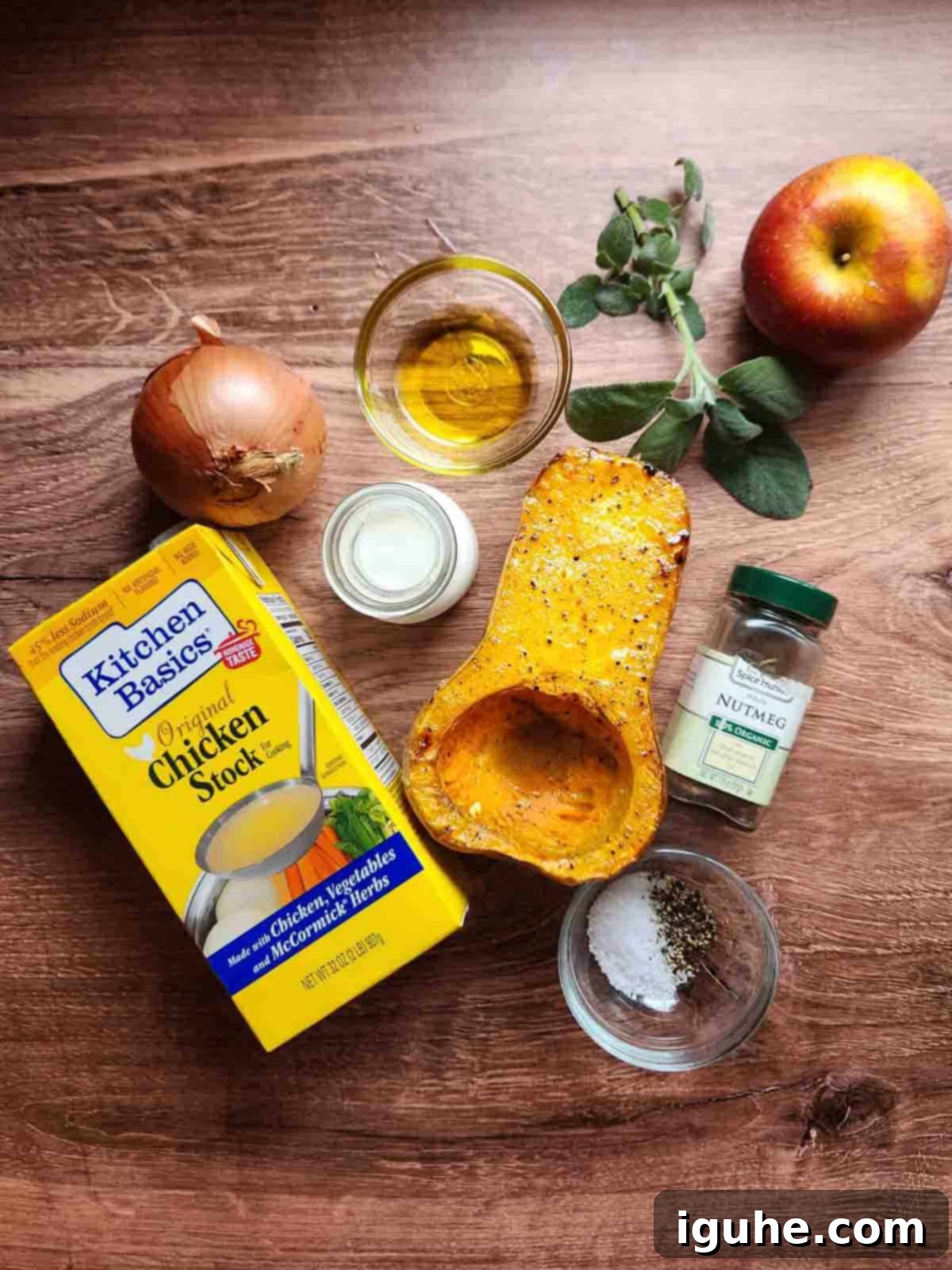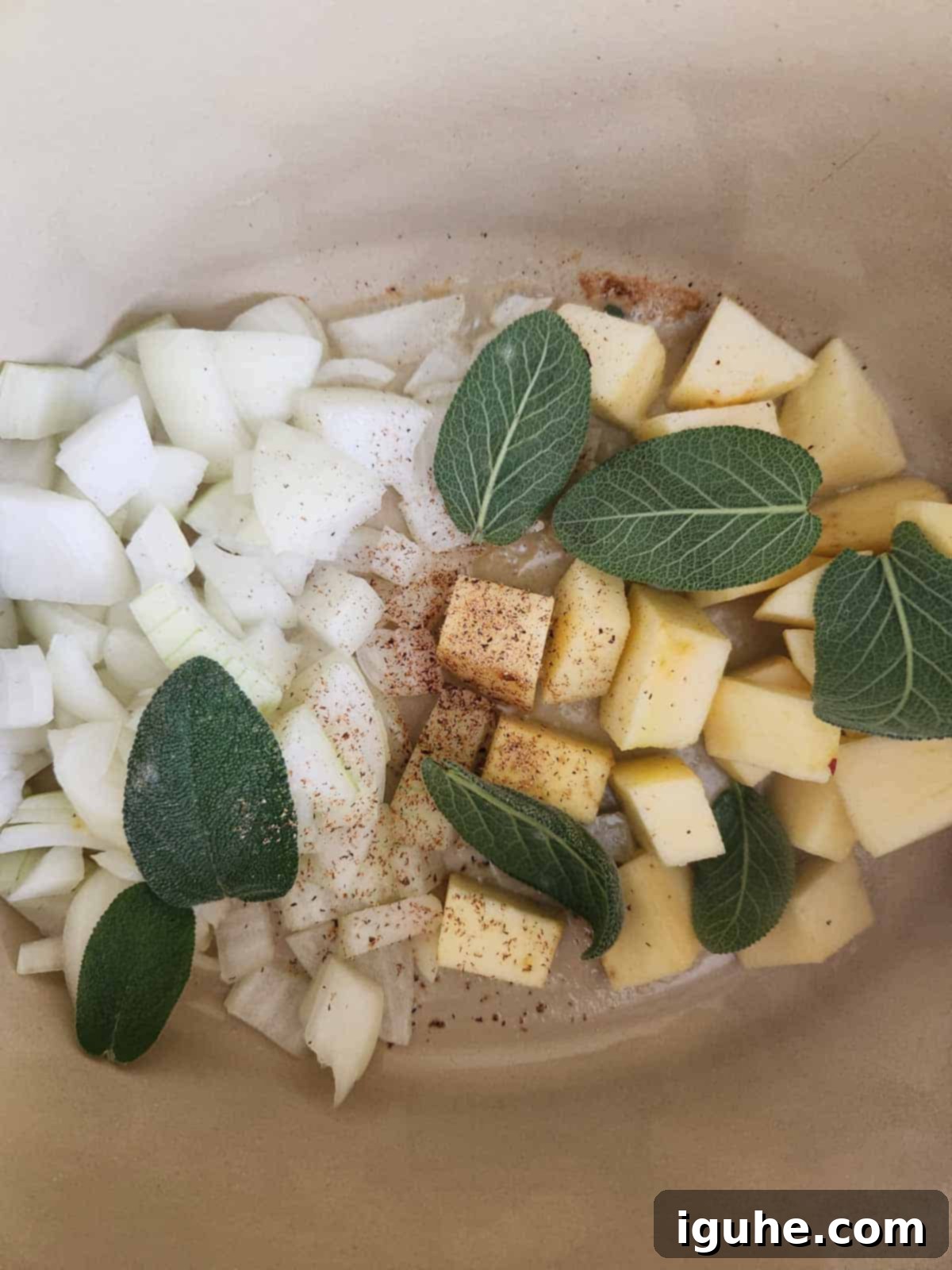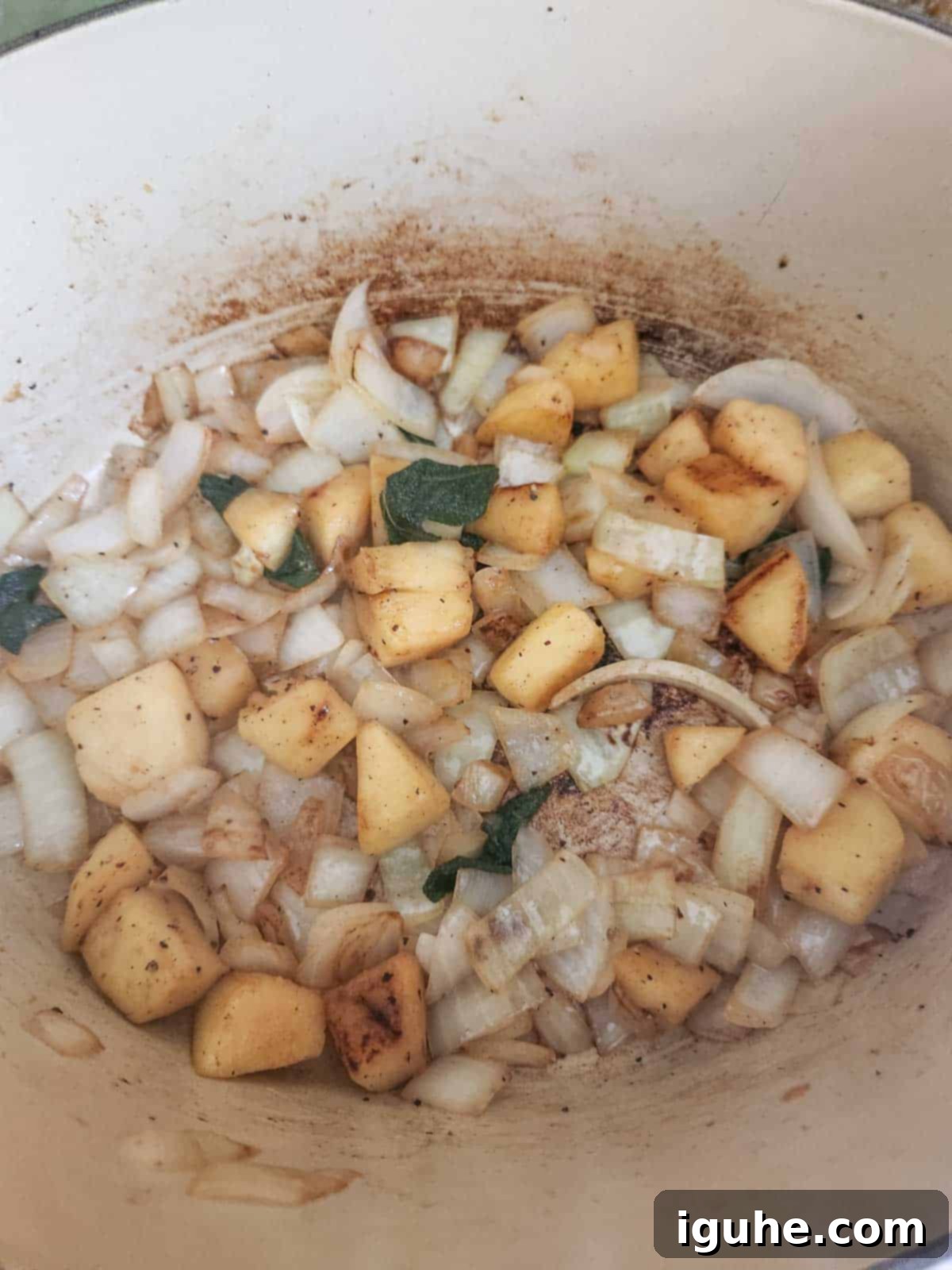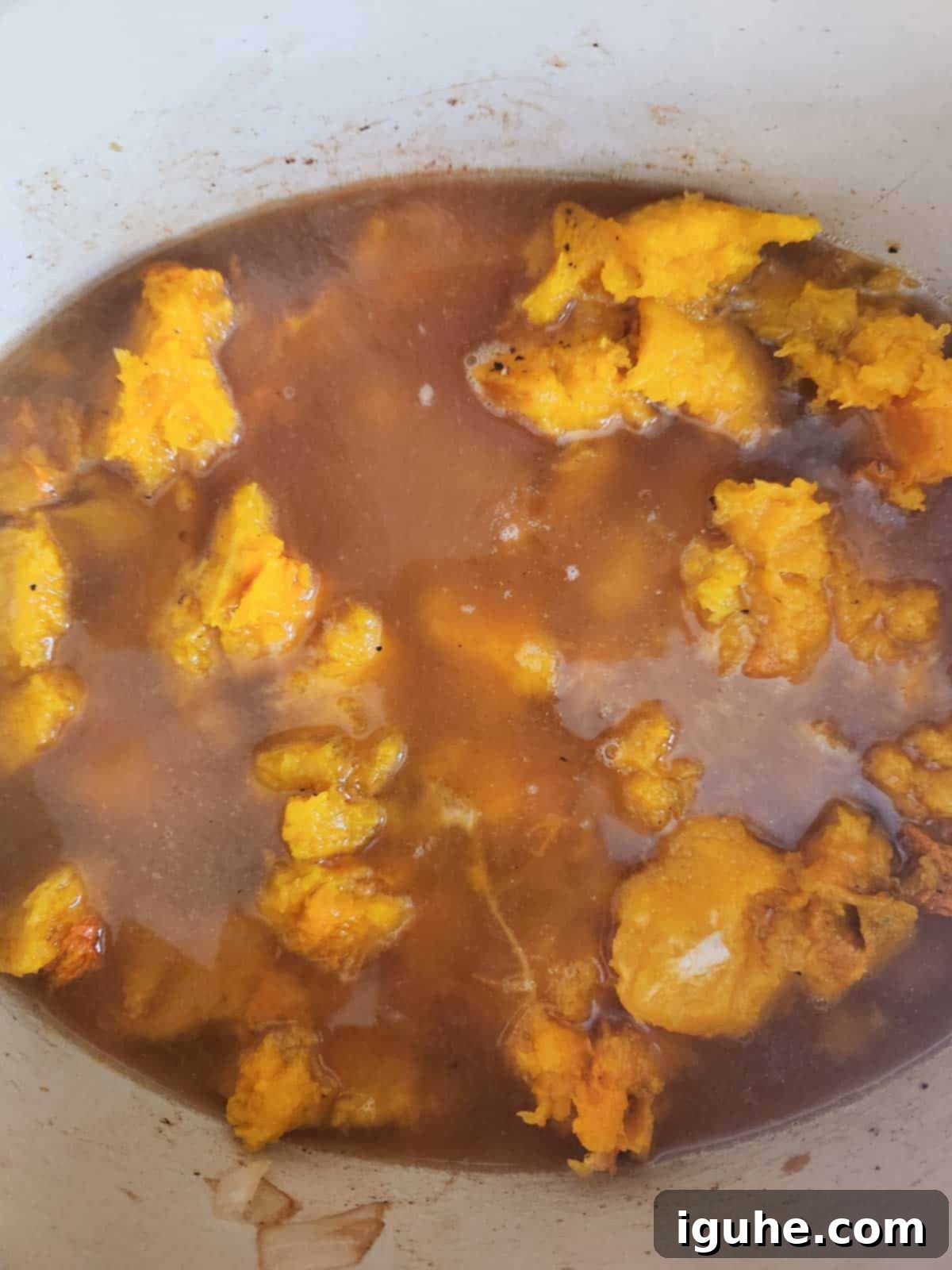The Ultimate Creamy Autumn Squash Soup: A Cozy Fall Favorite Recipe
As the leaves begin to change and a crisp coolness fills the air, nothing quite compares to the warmth and comfort of a homemade bowl of soup. This Creamy Autumn Squash Soup is the epitome of fall perfection. Crafted with beautifully roasted seasonal squash, sweet apples, and aromatic sage, it’s then blended into the most luxurious, silky-smooth texture imaginable. Every spoonful promises to chase away the chill and envelop you in cozy autumn bliss.

Autumn truly celebrates the magnificent world of squash. From vibrant oranges to deep yellows and greens, the rich hues of these seasonal gourds are what fall dreams are made of. Beyond their beauty, squashes offer a spectrum of flavors and textures, making them ideal for comforting dishes like this soup.
For this exquisite creamy autumn squash soup, you have the flexibility to choose almost any seasonal squash variety. Hearty options such as butternut, acorn, Hubbard, or kabocha are highly recommended as they provide the best flavor and creamy consistency. Roasting the squash first is a crucial step that enhances its natural sweetness and imparts a delightful nutty depth, while the apples contribute a subtle, refreshing sweetness that perfectly balances the savory notes.
[feast_advanced_jump_to]
Selecting the Best Squash for Your Creamy Soup
The world of autumn and winter squash is incredibly diverse, offering a range of flavors, textures, and appearances. While many varieties are delicious, some are particularly well-suited for creating a lusciously creamy soup. Understanding the characteristics of each can help you choose the perfect one for your culinary masterpiece.
For a truly exceptional creamy autumn soup, opt for a heartier, denser squash. Varieties like butternut, acorn, Hubbard, or kabocha are ideal. Their flesh breaks down beautifully when cooked and contributes to a naturally thick and velvety soup.
- Butternut squash: Universally loved for its sweet, nutty flavor and smooth, vibrant orange flesh. Butternut squash is incredibly versatile and a top choice for soups due to its creamy texture when pureed. It’s also commonly used in stews and as a roasted side dish. Its easy-to-peel skin after roasting makes it a convenient option.
- Acorn squash: Recognized by its distinctive small, round shape and dark green or orange-striped skin. Acorn squash offers a mildly sweet flavor and a slightly fibrous texture when roasted, which still blends wonderfully into soup. It’s often roasted halved or stuffed as a beautiful autumn centerpiece.
- Spaghetti squash: Unique for its string-like flesh that resembles spaghetti when cooked, making it a popular low-carb pasta alternative. While delicious when baked or roasted, its stringy nature means it won’t produce the silky-smooth consistency desired for this particular creamy soup recipe.
- Delicata squash: An oblong, small squash with cream-colored skin and striking green stripes. Delicata has a delicate, sweet, and nutty flavor. Its thin, edible skin means it can be roasted and consumed without peeling, but for the silkiest soup, peeling after roasting is still recommended.
- Hubbard squash: A large, robust squash available in various colors, including blue, green, and orange. Hubbard squash boasts a dense, very sweet flesh, making it excellent for pies, rich soups, and hearty casseroles. Its large size means you might only need a portion for your soup.
- Kabocha squash: Also known as Japanese pumpkin, kabocha offers a sweet, earthy, and nutty flavor with a dense, somewhat dry flesh. It’s a staple in Japanese cuisine and is fantastic roasted or incorporated into stews and curries. Its texture also lends itself well to a creamy soup.
- Sugar pumpkin: These smaller, sweeter pumpkins are specifically cultivated for culinary use, making them perfect for pumpkin puree in pies and other baked goods. They have a sweet, tender flesh that would also work beautifully in this creamy soup, offering a classic fall pumpkin flavor.
Essential Ingredients for the Creamiest Fall Squash Soup
Crafting this delightful fall squash soup requires a careful selection of ingredients that harmonize to create a rich, complex, and utterly satisfying flavor profile. Each component plays a vital role in achieving that perfect creamy texture and aromatic taste. Here’s a detailed look at what you’ll need:

- Squash: The star of the show! Choose a hearty variety like butternut, acorn, Hubbard, or kabocha for the best flavor and creamy texture.
- Olive oil: Used for roasting the squash, it helps caramelize the edges and enhance its natural flavors.
- Butter: Adds richness and a foundational layer of flavor when sautéing the aromatics.
- Apples: Any apple variety will work, but honeycrisp is recommended for its balanced sweetness and slight tartness, which brightens the soup. The apples cook down to add a subtle sweetness without overpowering the squash.
- Onion: Provides an essential savory base, sautéed until translucent to release its sweet, pungent notes.
- Nutmeg: Freshly grated nutmeg offers a warm, earthy, and distinctly autumnal aroma that pairs beautifully with squash. It’s a key spice for fall recipes.
- Chicken stock: Forms the liquid base of the soup. While chicken stock adds a rich savory depth, you can easily substitute it with vegetable broth for a vegetarian or vegan version without compromising flavor.
- Heavy cream: The secret to achieving that luscious, velvety, and truly creamy texture. Half and half can be used as a lighter alternative, but heavy cream delivers the ultimate indulgence.
- Sage: Fresh sage leaves are crucial for infusing the soup with a wonderfully fragrant, earthy, and slightly peppery flavor that defines autumn cuisine. Dried sage can be used in a pinch, but fresh is preferred.
- Salt and pepper: Essential seasonings to enhance all the flavors and adjust to your personal preference.
For the precise quantities and detailed instructions, always refer to the complete recipe card below.
Essential Equipment for a Perfect Soup
Having the right tools can make all the difference in preparing this creamy autumn squash soup. You’ll need a large baking sheet to properly roast the squash, allowing it to caramelize evenly and develop its deep, nutty flavors. A sturdy, large pot (such as a Dutch oven or stockpot) is necessary for sautéing your aromatics and simmering the soup base. Finally, to achieve the ultimate silky-smooth consistency that defines this recipe, a high-powered blender is highly recommended. Alternatively, an immersion blender can be used directly in the pot, offering convenience, though a stand blender typically yields a finer, more velvety texture.
Crafting Your Creamy Autumn Squash Soup: A Visual Guide
Follow these visual steps to prepare the most delicious fall squash soup. Remember, the full, detailed instructions with exact measurements are available on the recipe card below.

Preheat your oven to a hot 425°F (220°C). Prepare your chosen squash by halving it and scooping out the seeds. Place the squash halves skin side down on a large baking sheet, ensuring there’s enough space for even cooking. Drizzle generously with olive oil and season thoroughly with salt and pepper.

Roast the squash in the preheated oven for approximately 50 minutes, or until the flesh is incredibly tender and can be easily pierced with a fork. You’ll notice some browning and caramelization, which adds immense depth of flavor. Once roasted, remove from the oven and set aside to cool slightly before handling.

While the squash cools, prepare the aromatic base. In a large pot over medium heat, melt the butter until it sizzles gently. Add the coarsely chopped onions and apples, along with the fresh sage and a generous pinch of freshly grated nutmeg. These ingredients will infuse the soup with incredible fall flavors.

Sauté these vegetables, stirring occasionally, until the onions become translucent and the apples have softened, typically about 7 minutes. This gentle cooking allows the flavors to meld and deepen before the liquid is added, creating a robust foundation for your soup.

Once the roasted squash has cooled enough to handle, carefully scoop its tender flesh from the skin and add it to the pot with the sautéed onions and apples. Pour in the chicken stock (or vegetable broth) and bring the mixture to a rolling boil over high heat. This initial boil helps to integrate all the flavors and ingredients.

Once boiling, reduce the heat to medium-low, cover the pot, and let the soup simmer gently for about 15 minutes. This simmering time allows the flavors to fully meld and the ingredients to soften further. After simmering, turn off the heat and allow the soup to cool slightly before proceeding to the blending step. This is crucial for safety and achieving the best texture.

Once cooled slightly, carefully transfer the soup to a high-powered blender in batches and puree until it reaches a perfectly smooth, silky consistency. Alternatively, use an immersion blender directly in the pot, blending until no lumps remain. If the soup appears too thick, add a little extra chicken or vegetable stock until it reaches your desired creaminess. Return the blended soup to the pot, stir in the heavy cream, and bring it to a gentle simmer, cooking until it’s heated through. Taste and adjust seasoning with additional salt and pepper as needed.
Essential Blender Safety Tips for Hot Soup
Blending hot liquids, especially soup, can be a messy and even dangerous endeavor if not handled correctly. A common mishap is an “exploding soup” scenario due to steam buildup. To ensure your kitchen remains clean and you stay safe while achieving that perfectly smooth texture, follow these simple but critical steps:
- Cool the Soup Slightly: This is the most important rule. Always allow your soup to cool down for at least 15-20 minutes before attempting to blend it. Extreme heat creates steam, which needs to escape.
- Vent the Lid: If using a traditional stand blender, remove the small center cap from the lid. This opening allows steam to escape safely. Place a clean kitchen towel over the opening and the lid to prevent any splatters while blending.
- Blend in Small Batches: Never overfill your blender with hot liquid. Fill the blender pitcher only halfway, at most. Blending in smaller portions reduces the risk of pressure buildup and overflow.
- Start Slow and Increase Speed Gradually: Begin blending on the lowest speed setting and gradually increase to your desired speed. This prevents sudden pressure changes and keeps the hot liquid contained.
- Transfer Carefully: Once a batch is smooth, carefully pour it into a large, separate bowl. Repeat the process with the remaining soup until all of it is pureed.
Following these tips will help you avoid kitchen mishaps and ensure a smooth, safe blending experience every time.

Elevate Your Bowl: Serving Suggestions and Garnishes
While this creamy autumn squash soup is undoubtedly delicious on its own, a thoughtful garnish or accompaniment can transform it into an even more memorable meal. These optional additions not only add visual appeal but also introduce delightful textures and complementary flavors that truly take the soup to the next level. Experiment with some of these favorites:
- Toasted pumpkin seeds: A sprinkle of toasted pumpkin seeds (pepitas) adds a wonderful crunch and a subtle nutty flavor, contrasting beautifully with the smooth soup.
- Creamy drizzles: A swirl of extra heavy cream, half and half, or a dollop of tangy crème fraîche or sour cream right before serving adds an extra layer of richness and visual elegance.
- Gourmet oils: A delicate drizzle of high-quality olive oil, or a more adventurous flavored nut oil like walnut or pistachio oil, can introduce subtle new dimensions of flavor.
- Crispy sage: Fry a few fresh sage leaves in a small amount of olive oil until they are crisp and fragrant. Crumble these savory crispy sage bits over the top for an incredible burst of flavor and texture.
- Fresh nutmeg: A final grating of fresh nutmeg over each bowl enhances the soup’s inherent warmth and autumnal spice notes.
- Crumbled cooked bacon: For those who enjoy a smoky, salty addition, a scattering of crispy, crumbled cooked bacon adds an irresistible savory depth and delightful crunch.
- Toasted bread accompaniments: Offer textural contrast with golden toasted breadcrumbs, crunchy homemade croutons, or slices of crusty toasted bread perfect for dipping.
- Savory baked goods: Serve alongside warm, fluffy smoked gouda and chive scones or savory cheddar sage biscuits for a heartier, more satisfying meal.
- Light salad: A fresh and vibrant side like a burrata caprese salad with peaches provides a refreshing counterpoint to the rich soup.


Storage and Make-Ahead Tips
This creamy autumn squash soup is an excellent candidate for meal prepping, allowing you to enjoy its comforting flavors throughout the week or save it for a busy day. Proper storage ensures its freshness and delicious taste.
Refrigeration: Once cooled to room temperature, transfer any leftover cooked squash soup to an airtight container. It will keep beautifully in the refrigerator for 4-5 days. Simply reheat gently on the stovetop or in the microwave until warmed through.
Freezing: This soup freezes exceptionally well. For best results, allow the soup to cool completely before freezing. You can freeze it in an airtight freezer-safe container or portion it into individual servings in freezer-safe plastic bags. It will maintain its quality in the freezer for up to 3 months. When ready to enjoy, thaw the soup overnight in the refrigerator, then reheat on the stove over medium-low heat, stirring occasionally, until it’s piping hot. If the texture seems a bit off after thawing, a quick whisk or a brief re-blend with an immersion blender can restore its creaminess.
Frequently Asked Questions About Creamy Squash Soup
To achieve the absolute creamiest and silkiest soup texture, it is generally recommended to peel the squash. However, preparing raw squash can be tough. The good news is that roasting the squash first makes the skin incredibly easy to remove. Once roasted until fork-tender, the flesh practically scoops out of the skin with minimal effort, saving you time and struggle.
Several factors can prevent your soup from reaching that desired creamy consistency. First, ensure your vegetables (squash, onions, apples) are cooked until perfectly tender before pureeing. They should be easily pierced with a fork. If they are still firm, they won’t break down fully. Second, the type of blender you use makes a significant difference. A high-powered blender (like a Vitamix or Blendtec) is key to achieving a truly smooth, velvety consistency. While an immersion blender is convenient, it typically produces a slightly less creamy, sometimes chunkier, soup compared to a stand blender, though it will still yield a thick, pureed result. Finally, don’t forget the heavy cream at the end; it’s essential for the richness and smoothness.
Absolutely! This creamy autumn squash soup can be easily adapted for a vegan diet. Simply substitute the chicken stock with a high-quality vegetable broth. For the butter, use a plant-based butter alternative. And instead of heavy cream, opt for full-fat coconut milk or a rich cashew cream to maintain the luscious, creamy texture. The flavor profile will still be wonderfully autumnal and satisfying.
Delicious Pairings for Your Autumn Squash Soup
Looking for the perfect companions to serve alongside your warm bowl of autumn squash soup? These complementary dishes and sides will round out your meal beautifully, offering a delightful balance of flavors and textures.
- Smoked Gouda and Chive Scones
- Savory Cheddar and Sage Biscuits
- Rosemary and Fig Candied Bacon
- Burrata Caprese Salad with Peaches
Did you make this comforting creamy autumn squash soup? I would absolutely love to hear about your experience! Please consider leaving a ⭐⭐⭐⭐⭐ rating and a thoughtful comment right below the recipe card. If you capture a photo of your beautiful creation, don’t forget to share it on Instagram and tag me @brunchandbatter. Your feedback and photos truly make my day!
📖Recipe

Creamy Autumn Squash Soup
Pin Recipe
Equipment
-
large pot
-
baking sheet
-
blender or immersion blender
Ingredients
For the Roasted Squash
- 4 lbs autumn squash (about 2 medium), halved and seeded butternut, acorn, Hubbard, Kobacha
- 2 tablespoon olive oil
- 1 tsp Kosher salt or fine sea salt
- ½ tsp fresh ground pepper
For the Soup
- 1 tablespoon unsalted butter
- 1 apple, coarsely chopped any variety, I use honey-crisp
- 1 medium onion; coarsely chopped
- 8-10 fresh sage leaves
- ¼ teaspoon ground or grated nutmeg
- ½ teaspoon Kosher or fine sea salt
- ¼ teaspoon freshly ground pepper
- roasted squash see above
- 4 cups chicken stock/broth, plus more if needed can use vegetable stock
- ¼ cup heavy cream (or half n half)
- salt and pepper to taste
Instructions
To Roast the Squash
-
Heat the oven to 425°F (220°C).
-
Line a baking sheet with foil for easy cleanup. Place the squash cut side up and rub evenly with olive oil. Season generously with salt and pepper. Roast for approximately 50 minutes, or until the squash is beautifully browned, caramelized, and fork-tender. This crucial step deepens the flavor profile. Set aside to cool slightly. Once cool enough to handle, scoop the tender flesh from the skin and set it aside until ready to add to the soup base.4 lbs autumn squash (about 2 medium), halved and seeded, 2 tablespoon olive oil, 1 teaspoon Kosher salt or fine sea salt, ½ teaspoon fresh ground pepper
For the Soup
-
In a large, heavy-bottomed pot or Dutch oven over medium heat, melt the unsalted butter until it’s gently sizzling. Add the coarsely chopped onion, apple, fresh sage leaves, salt, and pepper. Sauté these aromatics, stirring occasionally, until they become soft and translucent, typically about 7 minutes. This develops the flavor base for your soup.1 tablespoon unsalted butter, 1 apple, coarsely chopped, 1 medium onion; coarsely chopped, 8-10 fresh sage leaves, ¼ teaspoon ground or grated nutmeg, ½ teaspoon Kosher or fine sea salt, ¼ teaspoon freshly ground pepper
-
Add the reserved roasted squash flesh into the pot with the sautéed onions and apple mixture. Pour in the 4 cups of chicken stock or broth (using vegetable stock if preferred). Bring the entire mixture to a vigorous boil over high heat. Once boiling, immediately reduce the heat to medium-low, cover the pot with a lid, and let it simmer for approximately 15 minutes. This allows the flavors to deepen and meld beautifully. After simmering, remove the pot from the heat and stir in the heavy cream.4 cups chicken stock/broth, plus more if needed, ¼ cup heavy cream (or half n half)
-
Allow the soup to cool slightly before blending. For a superior silky texture, carefully transfer the soup to a high-powered blender in manageable batches and puree until perfectly smooth. Alternatively, for convenience, use an immersion blender directly in the pot, blending until thoroughly pureed. If the soup is thicker than your preference, gradually add a little more stock or broth until it reaches your desired consistency.
-
Return the blended, creamy soup to the pot and gently heat through over low to medium heat, ensuring it doesn’t boil. Taste the soup and season with additional salt and pepper as needed to your preference. Serve this comforting autumn squash soup hot, garnished as desired.salt and pepper to taste
Notes
To freeze the soup, cool it completely, then transfer to an airtight freezer-safe container or portion into freezer-safe plastic bags. Store in the freezer for up to 3 months. To reheat, thaw overnight in the refrigerator and then gently warm on the stove until heated through.
Nutrition*
*Nutrition information is provided as a courtesy and is an estimate only. Nutrition information can vary depending on many factors, such as products used, measurements and substitutions, therefore it is recommended that you obtain nutritional calculations based on your own finished recipe.